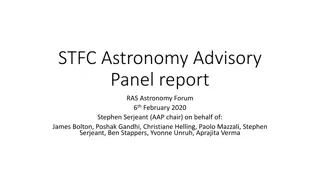Understanding RFI Mitigation Strategies in Radio Astronomy
Explore the key considerations and challenges related to Radio Frequency Interference (RFI) in radio astronomy, including when to consider RFI, important categories of RFI, and examples of RFI mitigation efforts at OVRO-LWA. Learn about dealing with persistent narrow-band RFI and impulsive or transient RFI, and how techniques like site selection, frequency selection, and signal processing can help in stabilizing trigger rates and minimizing false alarms.
Download Presentation

Please find below an Image/Link to download the presentation.
The content on the website is provided AS IS for your information and personal use only. It may not be sold, licensed, or shared on other websites without obtaining consent from the author. Download presentation by click this link. If you encounter any issues during the download, it is possible that the publisher has removed the file from their server.
E N D
Presentation Transcript
When to consider RFI When to consider RFI 1. Site selection 2. Selection of observing frequencies and design of analog electronics 3. Trigger design 4. Signal processing software-- classifying events, applying calibration 5. Reconstruction and analysis
Two important categories of RFI: 1. Narrowband transmissions can raise noise floor, even saturate ADCs if care is not taken 2. Impulsive or transient RFI can produce false alarm triggers
Examples from the OVRO-LWA: 1. Persistent, narrow-band RFI 0 -20 25 -30 -40 Power [dBm] Frequency [MHz] -50 Relative Power -60 -70 50 -80 -90 -100 20 60 80 40 0 Frequency [MHz] 75 Suppressed with analog and digital bandpass filters Filtering is necessary to stabilize trigger rate 100 200 800 1000 1400 Time [minutes since 22:23 PDT 4-Sep-2021 ] 4
Examples from the OVRO-LWA: 2. Impulsive or transient RFI: rejected by spatial distribution Array layout color-coded by FPGA Distant antennas veto RFI. Horizon Airplane reflections a) 1 Simulated emission 2 Peak Electric field [millivolts/m] 200 b) N-S position [km] 0.5 1.5 N-S Position [m] 0 1 c) 0 0.5 c) -200 Additionally use polarization, pulse shape -0.5 -200 0 200 E-W Position [m] -1 -1.2 -1 -0.8 -0.6 -0.4 -0.2 0 0.2 0.4 5 E-W position [km]























